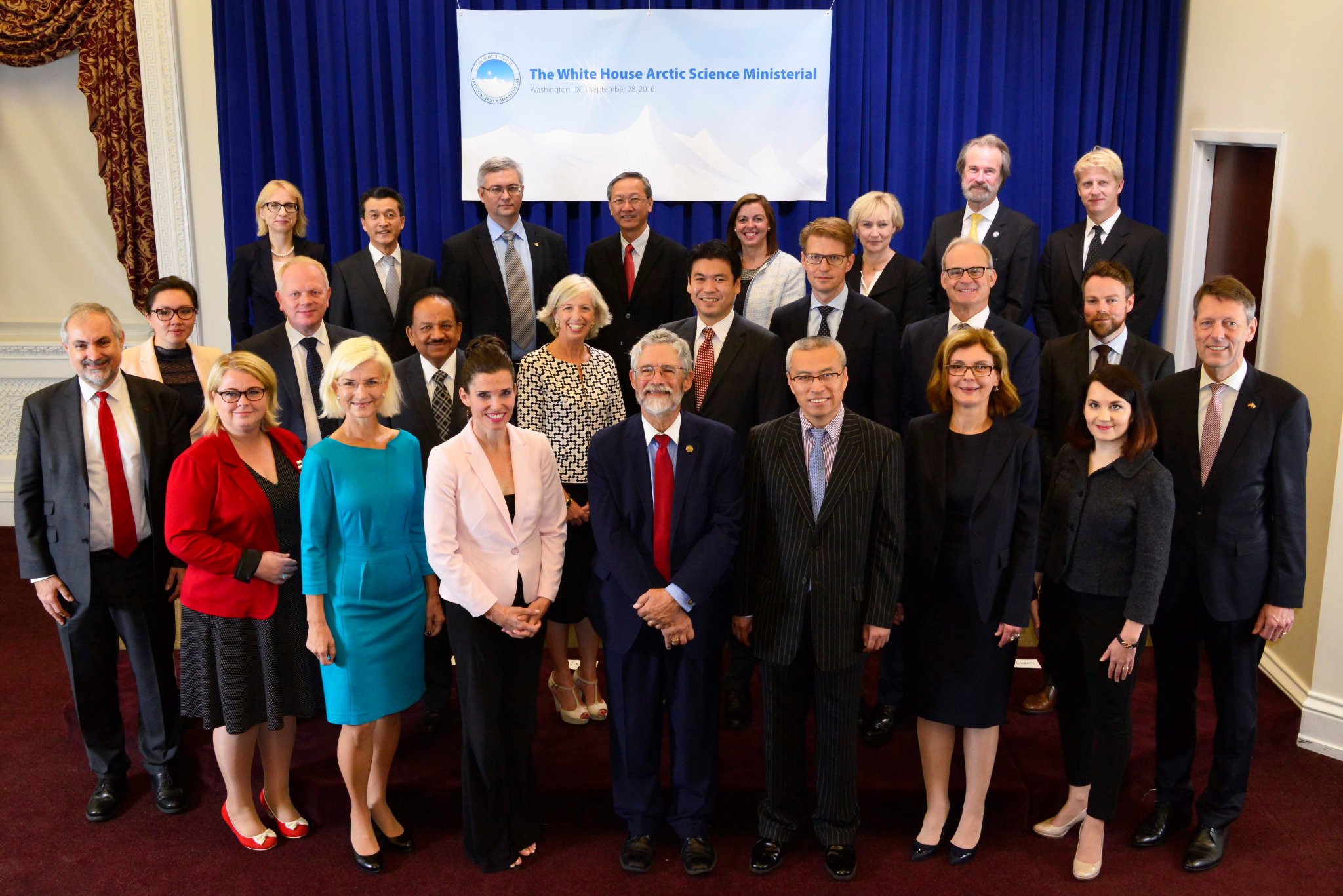A Legacy of Science Cooperation for Future Generations: The White House Arctic Science Ministerial

Representatives at the White House Arctic Science Ministerial. Photo: Connie Terrell, U.S. Coast Guard
The White House Arctic Science Ministerial (WHASM) Meeting, which took place on September 28, 2016 in Washington, DC, was the first of its kind in the history of Arctic cooperation. It was a special meeting organized by the White House, headed by the US President’s science advisor Dr John Holdren, and thus outside the general Arctic Council meeting agenda. Links to the official Arctic Council work are nevertheless discernible, such as the Council’s current efforts on a legally binding agreement on science cooperation in the Arctic.
This special meeting of science ministers and experts is a sign that Arctic actors are responding to the multiple tasks they face in times of rapid change in Arctic regions. Ensuring well-coordinated scientific efforts on Arctic transformations, and their consequences, is a prerequisite for gaining the necessary knowledge to shape societal, political, economic and legal responses to Arctic and global challenges. The WHASM is a sign of growing recognition among scientists and policy-makers that the ability to cope with the current and coming consequences of rapid (climate) change in the Arctic requires us to go beyond the current state of Arctic scientific efforts. While past and present research efforts are impressive, we need a greater diversity of the phenomena being studied (including societal and natural systems and, crucially, their interactions), a better temporal and spatial coverage of data collection and monitoring, and a strong integration of international and interdisciplinary efforts.
The WHASM encompassed a wide range of representatives including the science ministers and chief science advisors from the eight Arctic states and non-Arctic states with significant research activities in the Arctic and senior representatives from the five Arctic Indigenous Peoples’ Organizations. In total, 22 countries participated (the 8 Arctic countries, the 12 observer states to the Arctic Council, Switzerland and New Zealand) as well as the European Union. This wide array of representatives is an acknowledgement of Arctic regions being embedded in global systems and processes, and of the interdependencies between Arctic and global change. Accordingly, the key themes addressed at the WHASM reflect the regional-global interconnections:
- Arctic science challenges and their regional and global implications
- Strengthening and integrating Arctic observations and data sharing
- Applying expanded scientific understanding of the Arctic to build regional resilience and shape global responses
- Arctic science as a vehicle for science, technology, engineering and mathematics (STEM) education and citizen empowerment
The principal aim of the meeting was to expand joint collaborations on Arctic science, research, observations, monitoring, and data sharing, and to create a suitable environment for international scientific collaboration on the four themes so they can flourish over the long term. The latter is an especially difficult challenge since many scientific funding schemes are usually very limited in time and/or only researchers from certain countries are eligible to participate. To make Arctic long-term research efforts possible and inclusive would be a major step forward in our common aim of learning more about the Arctic’s natural and social systems and their interactions.
Deliverables designed to advance Arctic scientific knowledge and understanding were developed from project descriptions supplied by the 25 government representatives (22 countries, the EU and the Faroe Islands and Greenland) at the WHASM. These formed the basis of the discussion at the White House meeting. Building on this, the core deliverables, the White House Fact Sheet and the Joint Statement of Ministers, are a joint effort by all representatives to respond scientifically and cooperatively to the challenges of Arctic change. The cornerstones of the suggested efforts are increased international collaboration and inclusion of Arctic Indigenous Peoples in Arctic science and decision-making. The proclaimed goal is nothing less than a new collective approach in Arctic science, which is intended to inform national policies concerning climate change mitigation and resilience, Arctic development, stewardship, and the needs of Arctic Indigenous Peoples.
Representatives also pledged concrete initiatives, such as an Arctic observing system that includes Arctic indigenous knowledge; open and equitable access to Arctic research data for societal benefits; observation and data analysis ranging from hourly to decadal time scales; increase of regional resilience and adaptation capacity in the region; and cooperation on science, technology, engineering and mathematics (STEM) education including an international Arctic STEM Education Summit during the upcoming Finnish chairmanship of the Arctic Council. Furthermore, in preparation for the WHASM, the 25 participants were asked to prepare a two-page outline of their Arctic science activities. This resulted in a compendium of Arctic research activities, which will be released on the homepage of the US Arctic Research Commission, and is intended to provide an understanding of what each country is pursuing in terms of Arctic research and where synergies are possible.
Whether or not the Ministerial’s outcomes are put into practice and/or prove valuable to governments, scientists, Indigenous groups, and non-governmental organizations remains to be seen. Goodwill and human scientific capacity surely exist in the Arctic regions and beyond. Now it is up to the science ministers to make good on the pledges they made in the Fact Sheet and the Joint Statement and create the framework that will produce the finances, timelines and collaboration opportunities necessary to allow scientists and societal stakeholders to gather and apply their knowledge to the important Arctic issues at hand.
This commentary was originally published by the Canadian Science Policy Centre on 25 October 2016.